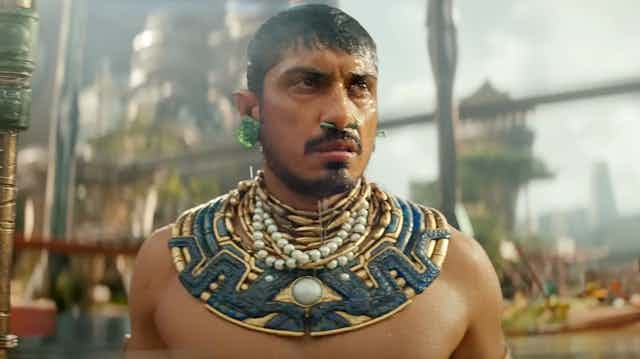Wakanda is back in cinemas, promising to deliver high-voltage action and trigger new discussions about how Hollywood represents other races and cultures. On November 10 Marvel’s Black Panther will receive its long-awaited sequel, Wakanda Forever.
The first film was considered a landmark in how Black culture is represented in mainstream movies, breaking box office records and earning a Best Picture Oscar nomination. Now there are hopes that Wakanda Forever will have a similar impact in its depiction of pre-Columbian culture.
Directed by Ryan Coogler, the first Black Panther became an exemplar of ethnic diversity in mainstream cinema, as well as a watershed moment for how film interacts with everyday racial politics.
NBA icon and cultural commentator Kareem Abdul-Jabbar described Black Panther as a “cultural spearhead disguised as a thrilling action adventure”.
if you’re white, you’ll leave with an anti-‘shithole’ appreciation for Africa and African-American cultural origins. If you’re black, you’ll leave with a straighter walk, a gratitude for your African heritage and a superhero whom black children can relate to.
At last, global Black culture was imagined by Hollywood as empowered and proud, and immune to the lasting effects of colonialism and forced migration.
Reimagining pre-Columbian culture
After Black Panther’s original star Chadwick Boseman tragically died in 2020, Marvel Studios had to reframe the future of the franchise, with Coogler deciding not to recast the lead role of T’Challa.
The story of Wakanda Forever centres around the political turmoil within the Afrofuturistic nation of Wakanda after the death of its king. Different factions must band together to repel the advances of a new enemy, the hidden undersea civilisation of Talokan, led by Namor (played by Mexican actor Tenoch Huerta).
In ancient Aztec culture, Talokan was the home of Tlaloc and his consort Chalchiuhtlicue, deities associated with rain and fertility. Marvel Studios has borrowed from pre-Columbian mythology to create a visually lush underwater civilisation based, in turn, on the character of Namor created by Bill Everett for 1939’s Marvel Comics #1.
The combination of an Aztec worldview and an old Marvel antihero could prompt concerns regarding cultural appropriation. However, given how Ryan Coogler and Marvel celebrated Afro culture in Black Panther, there is an expectation that this new Marvel movie will subvert stereotypes and expand wider understanding of the often misunderstood ancient cultures of what is now the Americas (known as the Kuna term Abya Yala by Indigenous activists and organisations).
Read more: How afrofuturism gives Black people the confidence to survive doubt and anti-Blackness
How Black Panther unleashed a wave of non-white heroes
Coogler’s first film proved that inclusivity can also be profitable in Hollywood. Since Black Panther, a wave of blockbusters have been released featuring non-white heroes and challenge Western-centric conventions of action-adventure cinema.
In the past year alone, films such as Shang-Chi (based on Chinese mythology), Black Adam (set in a fictional Middle Eastern country), and The Woman King (about a group of 19th century African female warriors) have provided a corrective to the historical disservice that Hollywood has done to so-called minorities.
Examples of mainstream cinema depicting pre-Columbian civilisations have been rare, and tend to cater to the tourist gaze by oversimplifying the history and richness of the Mesoamerican region. Films such as Mel Gibson’s Apocalypto, Steven Spielberg’s Indiana Jones and the Kingdom of the Crystal Skull, or the more recent live-action version of Dora the Explorer reduce complex civilisations later vanquished by European colonial forces to a handful of cliches.
These depictions misconstrue the history of civilisations that were highly advanced in science and technology compared to their European counterparts. They also have a negative impact on how millions of Latin Americans and Latinx individuals are represented onscreen and perceived in everyday life.

Namor reframed as an Aztec-inspired antihero
First appearing in comic books in 1939, Namor has traditionally been depicted as the sometimes-villainous king of Atlantis. Wakanda Forever repositions Namor’s underwater home to the Pacific Ocean and draws on Aztec and other pre-Columbian culture to realise this new Marvel hero.
The new Namor wears an Aztec-inspired headdress and armour, as well as facial piercings, and his underwater kingdom features buildings resembling Mesoamerican pyramids.

Mexican actor Tenoch Huerta, who stars as Namor, is one of the main voices of a social media campaign, #PoderPrieto (“Brown Power”), which fights against the white washing of the Mexican screen industry.
Contrary to fellow male Mexican actors who have been given diverse opportunities, up until now, the darker skinned Huerta has been typecast as a criminal and faced discrimination in the Mexican screen industry. Mexican film and television generally favours European-looking talent and systematically under-represents Indigenous Mexicans.
Read more: From Bruce Lee to Shang-Chi: a short history of the kung fu film in cinema
The release of Wakanda Forever coincides with renewed efforts by the incumbent Mexican government and activists to revisit the Indigenous and colonial histories of the country, and address systematic racism on and off-screen. For example, the federal government has demanded Spain and the Vatican apologise to Indigenous Mexicans over human rights abuses during the conquest over 500 years ago.
Huerta has spoken about the importance of inclusivity and representation of non-white characters in superhero movies. When Huerta was first unveiled to be playing the iconic character at San Diego Comic-Con he explained to the thousands of fans in attendance “I wouldn’t be here without inclusion”, and then switching to Spanish said “Thank you to all the Latin Americans – you guys crossed the river, and you all left everything you love behind. Thanks to that, I’m here.”
The first Black Panther film was a milestone in Black representation on-screen, now it is hoped Wakanda Forever will be both a mirror and a spotlight for millions of Latin Americans, as well as for the vast Latinx diaspora around the world.

